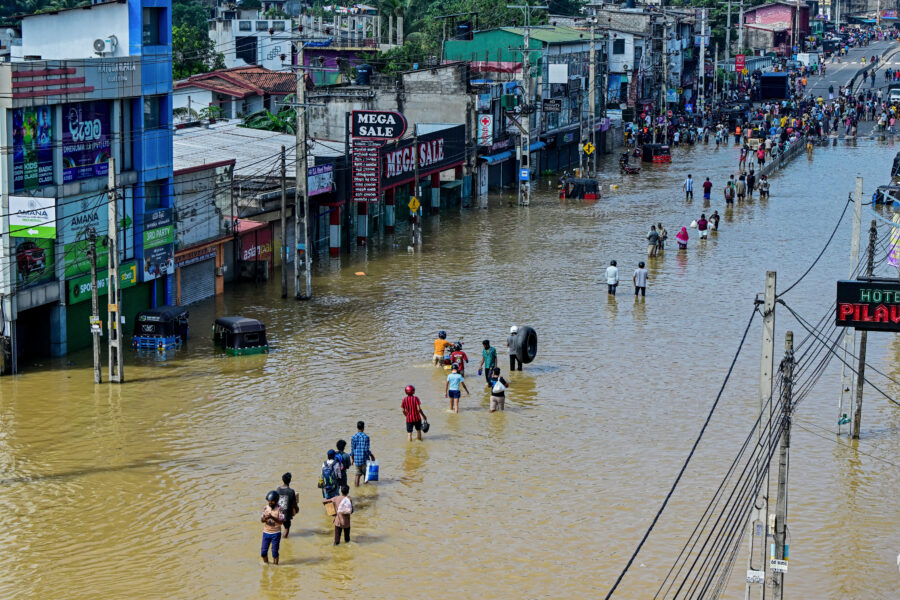The small island nation of Tuvalu is being swallowed by the sea.
With just around 10,000 residents, this Pacific network of reef islands and atolls has seen sea levels rise around 6 inches over the past three decades—one and half times the global average. Tides are projected to climb another 6 inches by 2050, which means the entire nation could soon be submerged.
As locals scramble to combat this (somewhat) slow-motion catastrophe, leaders have worked with Australia to create an escape route: a first-of-its-kind “climate visa” that will allow 280 Tuvaluan people to obtain permanent residency in the larger country each year. The Australian visa lottery launched two weeks ago, and nearly half of Tuvalu’s residents have already applied, The New York Times reports.
The move is representative of a growing global trend of climate-fueled migration. Millions of people in countries across Latin America, Africa and Asia—and even more developed countries like the U.S.— have been forced to flee their homes in the face of sea-level rise, extreme weather and other global warming impacts.
These population shifts come with a range of diplomatic, logistical and emotional complexities. And with climate change invading every corner of the world, experts are asking two crucial questions: Where will everyone go—and is anywhere really safe?
A Nation Underwater: Tuvalu’s nine islands add up to less than 10 square miles, making it one of the smallest countries in the world. Its residents have a strong connection to the environment but have struggled to adapt to the drastic changes that sea-level rise have brought to their island communities.
As high tides inundate the coastlines, saltwater is increasing the salinity content in soil and making it harder to grow crops such as taro, which locals depend on for food. Meanwhile, flooding has repeatedly destroyed homes and infrastructure in recent years. People are creating burial sites closer to their homes as cemeteries erode, a growing issue with climate change that I wrote about last year.
“This for us is about our identity,” Talua Nivaga, a youth delegate from Tuvalu, said at a United Nations climate summit in 2023, which my colleague Nicholas Kusnetz covered. “Every inch of land that is flooded takes with it centuries of our heritage, of our traditions and our memories.”
In 2017, the government launched a project to build resilience against climate risks through beach restoration, seawalls and other strategies. However, recognizing that the rising tides may soon prove unrelenting, the Tuvaluan government worked with Australia to craft a different pathway—to allow people the option to leave altogether.
Launched last year, this visa treaty aims to provide “a pathway for mobility with dignity as climate impacts worsen,” according to the Australian government. Applications opened last week and will be accepted until mid-July.
Some locals have expressed opposition to the approach, while others are hoping to secure a visa and explore education or job opportunities in Australia, the Guardian reports.
“There’s a lot of excitement around the migration pathway, both in Tuvalu and among our diaspora,” Tuvalu’s prime minister, Feleti Teo, told the Guardian. “It doesn’t mean you have to live the rest of your life in Australia. You can go in and come out as you wish.”
A Broader Trend: Tuvalu is not the only country seeing a climate-exacerbated reshuffling. In 2022, an estimated 32 million people were forcibly displaced within their countries by weather-related events such as floods, storms and wildfires, research found. The climate migration problem is particularly severe for small island nations and countries in the Greater Horn of Africa, where up to 10 percent of the population is expected to become climate migrants over the next few decades, according to research from the Global Centre for Climate Mobility.
A 2020 analysis found that extreme weather and natural disasters could displace as many as 1.2 billion people as ecological changes fuel civil unrest and financial losses, CNN reported. This looming reshuffling of the world’s population could have profound implications on global politics and economies, experts say.
For example, experts warn that if too many people leave Tuvalu or other nearby nations like Kiribati and Fiji too quickly, the local economy and access to certain social services could suffer. Also, the escape plan—Australia—is not without its own climate struggles. As Scientific American editors wrote in the wake of Hurricane Helene last September: “There are no climate havens.”
In the United States, researchers predict that millions of people may choose to move to new areas due to wildfires, hurricanes and flooding. Even if their actual homes weren’t destroyed, the cascading impacts of these events such as insurance premium hikes, long-term health hazards and civil unrest could trigger a diaspora.
Climate-driven displacement comes with an emotional burden. Tuvalu has a unique solution to preserve pieces of the nation’s cultural identity in the face of rising tides: building a digital replica in the metaverse.
“The world’s inaction has led our Pacific region to take greater action and forge our own path as leaders on the international stage, but our action alone cannot stop the current trajectory of climate change,” Simon Kofe, a member of Tuvalu’s Parliament, said in a video announcing the project in 2021. “Only concerted global effort can ensure that Tuvalu does not move permanently online and disappear forever from the physical plane.”
A Note to Readers
Today’s Climate readers, we have a few exciting updates for you.
First, we will be switching the newsletter from twice a week to once a week. It’s not because we are downsizing, but rather we are expanding our coverage on conservation and wildlife, which I will be reporting on more extensively in the coming months.
The second update is something I need your help with: We are introducing a new feature in the newsletter called “Postcards From,” in which I’ll be asking readers (and my colleagues) to send in a nature photo from your lives that we can include here.
These can be photos from anywhere—a desert cactus you spotted on a hike, a snapshot of your favorite beach, a cool bird you saw in a city tree (because urban nature counts too!). They can also be images of the ways that climate change is touching your lives—from wildfires in California to hail storms in the Midwest.
It’s easy to forget that we are all surrounded by nature. This feature, which will start soon, will show how our Inside Climate News community is connected to the environment.
I can’t wait to see what you send in. Email your photos to me at [email protected].
More Top Climate News
Barcelona experienced its hottest June in more than a century amid a heat wave that continues to bake much of Europe, Samuel Paterquin and Joseph Wilson report for The Associated Press. The most severe heat is currently sizzling France, Italy and Spain, where temperatures are rising past 100 degrees Fahrenheit—well above seasonal norms, scientists say. The conditions come a week after a heat dome gripped much of the U.S. In recent weeks, I wrote about health threats associated with nighttime heat and challenges with technology to cool us down.
Last week, the National Oceanic and Atmospheric Administration announced it would stop providing certain storm data from satellites, information crucial to hurricane forecasts in recent decades. However, on Monday, the Trump administration said it will delay the phase out of this tool for one month following pushback from meteorologists and scientists, including a top official at NASA, Emily Mae Czachor reports for CBS News. The satellite program gathers real-time details about atmospheric and oceanic conditions, which contributes to a network of data and monitoring tools that feed into federal hurricane forecasts. It will be discontinued by July 31, right in the midst of Atlantic hurricane season.
A number of agencies, including the Department of Energy, the Federal Energy Regulatory Commission and Department of Agriculture, have started rolling back regulations governing how they handle environmental reviews under the National Environmental Policy Act. The bedrock law requires agencies to consider ecological risks before greenlighting projects on federal lands. Some agencies proposed new regulations to replace past NEPA procedures, but the updated language makes clear that streamlining infrastructure and energy projects is the priority, Ethan Howland reports for Utility Dive.
“These reforms replace outdated rules with clear deadlines, restore agency authority, and put us back on the path to energy dominance, job creation, and commonsense action. Build, baby, build!” the agency’s secretary, Chris Wright, said in a press release.
About This Story
Perhaps you noticed: This story, like all the news we publish, is free to read. That’s because Inside Climate News is a 501c3 nonprofit organization. We do not charge a subscription fee, lock our news behind a paywall, or clutter our website with ads. We make our news on climate and the environment freely available to you and anyone who wants it.
That’s not all. We also share our news for free with scores of other media organizations around the country. Many of them can’t afford to do environmental journalism of their own. We’ve built bureaus from coast to coast to report local stories, collaborate with local newsrooms and co-publish articles so that this vital work is shared as widely as possible.
Two of us launched ICN in 2007. Six years later we earned a Pulitzer Prize for National Reporting, and now we run the oldest and largest dedicated climate newsroom in the nation. We tell the story in all its complexity. We hold polluters accountable. We expose environmental injustice. We debunk misinformation. We scrutinize solutions and inspire action.
Donations from readers like you fund every aspect of what we do. If you don’t already, will you support our ongoing work, our reporting on the biggest crisis facing our planet, and help us reach even more readers in more places?
Please take a moment to make a tax-deductible donation. Every one of them makes a difference.
Thank you,













